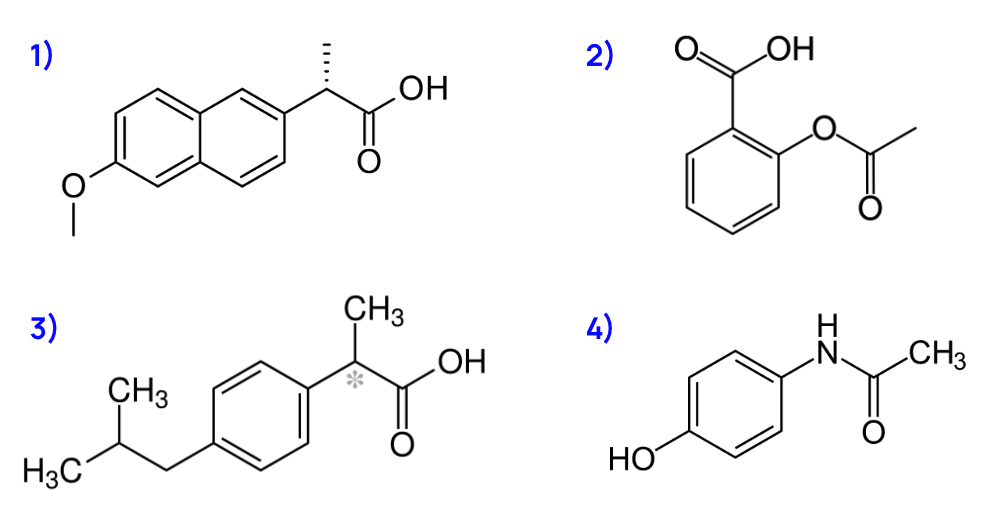Ibuprofen vs. aspirin vs naproxen vs acetaminophen
Ibuprofen, aspirin, naproxen, and acetaminophen are the most common drugs for pain relief. They’re staples of the modern pharmaceutical arsenal, and they’re in virtually every American home. After years of not bothering to learn the difference between them, I finally sat down and did it yesterday, and I figured I’d write this as a reference. I’ll give a bit about each drug, and then close with some bigger questions that feel interesting to me.
Basic drug facts
Ibuprofen (brand names Advil, Motrin) is a “non-steroidal anti-inflammatory drug” (NSAID). As the term suggests, it’s an anti-inflammatory drug, so it’s particularly useful for treating pain caused by inflammation, including headaches, menstrual cramps, and arthritis. It works by temporarily binding to (and thus interfering with) “cyclooxygenase” (COX) enzymes which produce prostaglandins, which are involved in pathways for inflammation. It was developed in the 1960s as a safer alternative to aspirin.
Aspirin (which apparently has no brand names) is a different NSAID. It’s sometimes prescribed for long-term use as a means of reducing the risk of heart attacks. It also works by binding to COX enzymes, but interesting, in the case of aspirin, this binding is permanent – it stays bound until the enzyme is destroyed! It’s pretty old – it was developed in the late 1890s! It’s more dangerous than ibuprofen, though, with more risk of side effects on the digestive system, which I imagine is why ibuprofen is the more common over-the-counter medication these days.
Naproxen (brand name Aleve) is also an NSAID and also dates from the 1960s. It acts very similarly to ibuprofen, but it lasts maybe 2x longer (but takes a bit longer to kick in).
Acetaminophen (brand name Tylenol; also called paracetamol internationally) is not a NSAID. It still affects the same pathway as NSAIDs, though, interfering with COX enzymes, and generally seems pretty similar, though it’s still a mystery how exactly it works. It has fewer side effects, but seems to have much higher risks of overdose – in fact, it’s responsible for more overdoses than any other drug in the Western world! It seems to primarily harm the liver and combine particularly poorly with alcohol.
In my home growing up, there was also a small bottle of something called “excedrin.” Somewhat ridiculously, this looks to be a combination of aspirin, acetaminophen, and caffeine!
So what are these things anyways?
These drug facts are well and good – it’s nice to know the effects of these substances – but what are they? Each substance consists of just one fairly small molecule. Here they are – see if you can guess which is which. Answers are at the bottom of the page.

I find it pretty amazing that these small molecules can have such specific effects! The body is huge and has a truly immense number of processes going all the time, and these molecules are taken orally and presumably spread throughout most of the body, and they don’t seem complicated enough to be addressed to a very specific function, and yet they specifically target one particular enzyme in one particular pathway. It’s even more surprising to me that multiple simple molecules all do this job – though perhaps that’s just an indication that that enzyme is easily messed with.
Looking at these molecular structures, I’m reminded anew of how weird and unintuitive biochemistry tends to be. If you show me a picture of a mechanical part and tell me what it does, I can generally imagine how it might perform that role, and how a similar part might not be as good a choice for it, but I almost never have this experience looking at a biomolecule, and when I find out how the biomolecule works, it usually sounds ad hoc and overly complicated to me! I wonder if learning some basic biochemistry would make things seem more mechanically intuitive.
The molecules are 1) naproxen, 2) aspirin, 3) ibuprofen, and 4) acetaminophen. I have no idea how you could guess this, so congratulations if you did.